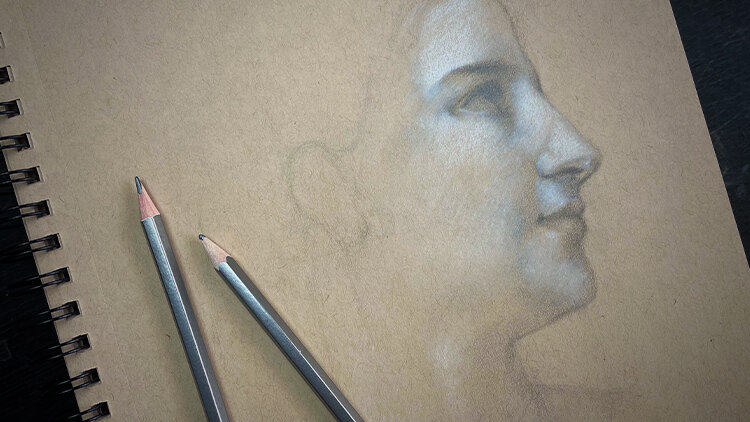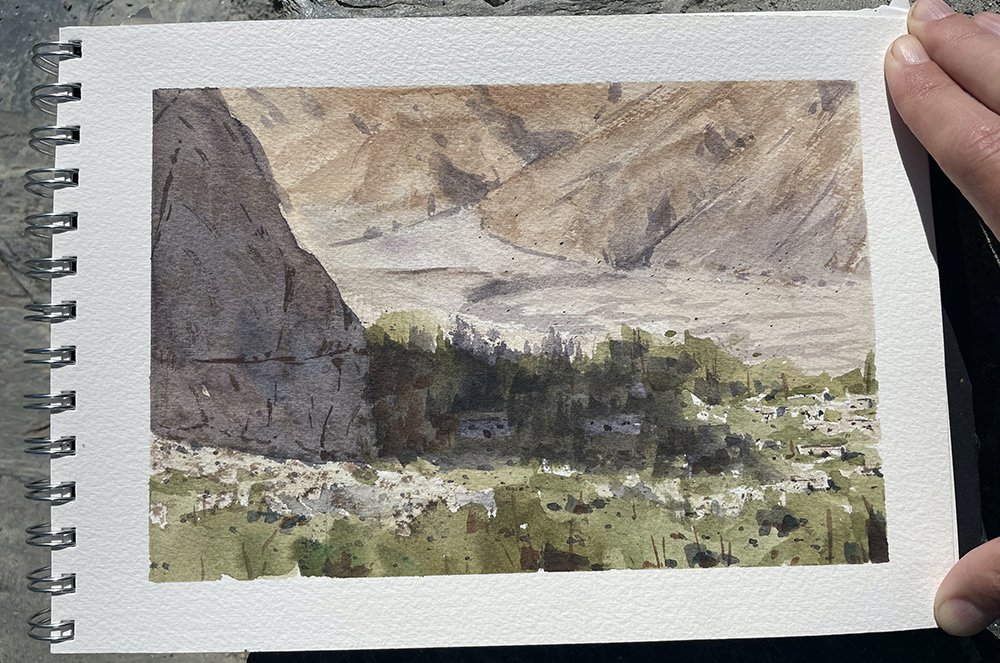Understanding Light & Shadow - A Painter’s Perspective
I'm very much a visual learner so for this post, I'm going to rely a little bit on some images to help get my points across. Also, understand I do not have all the answers and I don't claim to have them - I'm only giving my understanding from what I've come across thus far in my journey. Hopefully it will help you in some way. Not sure where exactly to start, so I will start from the beginning.
To understand shadows, we must understand light and its spectrum. All colors of light mixed together creates white light - the absence of all light is shadow which is 'black'.
Now, we must understand the world we as artists work in, which is pigment. All pigment mixed together creates 'black'. I would guess the absence of any pigment is just... nothing or white if you're thinking of a canvas. The primary colors you decide to use are up to you, but I'm just trying to get the concept across at the moment.
Light and pigment are two completely different worlds as I described above. I will explain later why this is important to understand.
In case you may not know, here are the complementary colors - these will change if you use different primaries such as the HSV color wheel or some other set of colors. I'm using Red, Blue & Yellow for simplicity and familiarity.
This one is self explanatory. I believe we all have an understanding of warm and cool for the most part - in a general sense at least.
Now, this is where it all becomes interesting - Relativity. We must also understand that within those sets of warms from above, there are also cooler warms. Same goes for cool colors as well.. there are warmer cools and cooler cools. And in a scene or a painting there are warms and cools within the lights and warms and cools within the shadows.
Here I've chosen four different colors from the chart above. The 2 on the left appear warmer than the 2 on the right. If I were to remove the 2 colors on the left, then one color out of the 2 on the right would become warm and the other would become cool. See what I mean? It's all relative. If I lost you there, just keep reading.
Check out this little image I made. What is the answer to: "Is the sun Big or Small?" - The question you should then ask is: "Compared to WHAT?". Compared to a golf ball the sun is very large. Compared to HR 5171A the sun is quite small. So the sun is big and small? Once again, it is all relative. You may be thinking, what does any of this have to do with shadows? It shall all come together.
Now this image is all speculation - at least to me. I unfortunately do not own any colored lights like these, so I cannot say for sure if this is true or false. I look forward to picking some up eventually and doing an experiment. If I do so, I will update this post and let you know. For now, just keep this in mind as a possibility or try it yourself. UPDATE: I made a video demonstrating this phenomenon:https://youtu.be/PxLt9njZpg8
These next two images are where I believe there is a huge misconception or misunderstanding within the painting world. The main point of this post is to discuss shadows and their temperature, color & other aspects in order to achieve a realistic image. A general guideline that has been talked about for years is "Warm light, cool shadows or cool light, warms shadows". To most that statement means warm/orange light must mean blue/cool shadows while cool/blue light must mean orange/warm shadows. I believe this to be incorrect. I do not believe that it has to be that blatant or obvious. I actually got these photos from another blog which talks about shadow misconceptions but to me, they still missed the mark.
If we look at the images below, we can see that the first image shows a warm light source and believe it or not - a cool shadow. "How can that be? The shadow is clearly orange/brown!". We are artists, must think in terms of pigment. Think about how you would paint this scene. Also, remember relativity. The orange in the light is without a doubt more warm than the shadow. The reason being that in order to create that darker, neutral shadow blue must be mixed with orange. This means that there is more blue in the shadows than in the light [there wouldn't be any blue in the light]. So this scene to me would be warm light and cool shadows still.
Understanding what I just said above, let's apply the same concept to this scene. The blue light is definitely cooler than the shadow. Think about color mixtures again. It is blue in hue, but neutral - to create that neutrality you must mix its complement - orange - a "warm" tone. This leaves us with more warm tones in the shadows than in the light. So once again to me, this scene is cool light and warm shadows.
Of course, this isn't always the case. In nature and in life, there are factors for everything. Warm reflected light could warm up a shadow that would naturally be 'cooler'. An object near the shadow could influence its hue/color. Depending on what your object is sitting on, the color of the shadow will vary. Also the color of your object could be a factor. So many situations, so many possibilities.
Here's another complementary image which is speculation, to me anyway. UPDATE: I made a video demonstrating this phenomenon:https://youtu.be/PxLt9njZpg8
And here's one to show some different lighting situations and how light can affect the entire scene - objects, colors and shadows.
Here is what Richard Schmid has said regarding shadows: "A good basis is your ability for observation. A knowledge of the characteristics of light - the chief ones are that cool light produces relatively warm shadows and warm light produces relatively cool shadows. That simple rule is the probably a good basis for establishing shadow and highlight color... The one exception to this rule that I've found - the most common one - is that regardless of whether you are working in cool light or warm light, the darkest dark accent in any shadow is going to be very hot. In other words, it is going to be a mixture of alizarin crimson and transparent oxide red pre-dominating in a mixture with a little bit of maybe ultramarine blue.. to give it a little deeper color but it doesn't seem to matter whether it's warm light or cool light, the darkest possible dark accent is going to be hot, very hot - the hottest color on your palette and the darkest color on your palette."
Notice what Schmid says right at the beginning which is very important: "cool light produces relatively warm shadows". You have to compare the tones in your scene or painting to each other. Also take note that you must observe.
Here's what Brad Teare says about shadows: https://www.youtube.com/watch?v=k8qMS5cd4KI
Draw Mix Paint on shadow colors: https://www.youtube.com/watch?v=JfUE8VYFEcg
Daniel Edmondson on shadows: https://www.youtube.com/watch?v=C8bBdOelbrQ
Pay attention to Edmondson's video and see what he compares towards the end. I believe there is some flaws within his experiment and explanation. He compares two different scenes with two different light sources - rather than comparing the light to the shadow of one particular scene. For instance, in his cool light photo - he should compare the cool light to the shadow and understand what mixtures he's going to need. Instead, he compares this photo's shadow to the warm light photo's shadow which wouldn't happen in nature or in your painting.
If you compare the light to the shadow, you will see what color mixtures you need and understand which is cooler and which is warmer. He also places his objects on a warm wooden table which reflects light into the shadows, which needs to be noted. But I do agree with him about the impressionistic view on light and shadows. The cooler shadows outside are due to reflected light from the blue sky. This does appear in nature but not inside for still lifes. But!.. thinking in terms of pigment, since we are artists and not scientists - I showed in the images above that even if an entire scene is blue, there are warms and cools within that scene. You shouldn't compare the blue cube's shadow to the orange cube's shadow because you'd only paint one in a single scene most likely.
My Conclusions
I think it is best to paint what you observe. Outside in nature, there is warm light & cool shadows [reflected blues further cooling the shadows] on sunny days and cool light with warmer shadows on cloudy/overcast days. There are also shadows that don't appear to be visibly cooler or warmer but the mixtures you create with your pigment will show that to be the case in a subtle way. There are also many other factors involved with shadows such as reflected light & color which could change the warm light/cool shadows. Always know what you are painting: Light, Midtone, Shadow, Reflected Light or Accents [light & dark]. If you get the value and temperature correct, it should read as realistic.
Hope this was helpful. Post any comments or questions below!
What do you find most challenging about painting shadows?
Be sure to leave me a comment or share it if you found it helpful!
[Note: Some of the links in the paragraphs above are affiliate links which help me to create new content and keep this site running. I am not sponsored by any brands or companies.]

I am an artist, writer, and instructor. As a previous graphic designer for a healthcare management business, I now teach drawing, painting, and discovering your passion with art.
When You’re Ready, Here’s How I Can Help You:

Unlock your artistic potential and learn to draw with confidence using the Intuitive Drawing method. From your first sketch to creating realistic drawings and subjects.



























